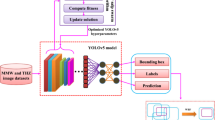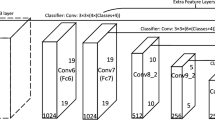Abstract
In public spaces, conducting security checks to detect concealed objects carried on the human body is crucial for enhancing global anti-terrorist measures. Terahertz imaging has recently played a pivotal role in concealed object detection. However, previous studies have faced significant challenges in achieving superior accuracy and performance. To address these issues, we propose a YOLOv5m model for detecting hidden objects beneath human clothing. We employ the CSPDarknet53 block to reduce noise and enhance discriminative power. Object location and size are identified using a PANet and the prediction head. To reduce computational complexity and obtain highly relevant features, we utilize multi-convolutional layers. Duplicate boxes are eliminated and high-quality bounding boxes are accurately detected using the NMS block. Hyper parameter tuning is performed using the Mutation Enabled Salp Swarm Algorithm, resulting in improved detection accuracy and reduced processing time. Our proposed model achieves impressive metrics, including a precision of 98.99%, recall of 97.80%, F1 score of 98.05%, detection rate of 96.50% and execution time of 135 s. Comparatively, our method outperforms existing approaches such as CNN, YOLO3, AC-SDBSCAN, YOLO-v2, RaadNet and SPFAN. We train and test our proposed method using a terahertz video dataset, demonstrating excellent results with high precision.









Similar content being viewed by others
Data availability
The data that support the findings of this study are available from the corresponding author upon reasonable request.
References
Liang D, Xue F, Li L (2021) Active terahertz imaging dataset for concealed object detection. arXiv preprint arXiv:2105:03677
Amadi L, Agam G (2023) Weakly Supervised 2D pose adaptation and body part segmentation for concealed object detection. Sensors 23(4):2005
Liu T, Zhao Y, Wei Y, Zhao Y, Wei S (2019) Concealed object detection for activate millimeter wave image. IEEE Trans Industr Electron 66(12):9909–9917
Cheng L, Ji Y, Li C, Liu X, Fang G (2022) Improved SSD network for fast concealed object detection and recognition in passive terahertz security images. Sci Rep 12(1):1–16
Morozov AA, Sushkova OS (2021) Development of a publicly available terahertz video dataset and a software platform for experimenting with the intelligent terahertz visual surveillance. In: Proceedings of International Conference on Frontiers in Computing and Systems: COMSYS 2020, Springer Singapore, p 105–113
Feng H, An D, Tu H, Bu W, Wang W, Zhang Y, Zhang H, Meng X, Wei W, Gao B, Wu S (2020) A passive video-rate terahertz human body imager with real-time calibration for security applications. Appl Phys B 126(8):143
Yağ İ, Altan A (2022) Artificial intelligence-based robust hybrid algorithm design and implementation for real-time detection of plant diseases in agricultural environments. Biology 11(12):1732
Sezer A, Altan A (2021) Detection of solder paste defects with an optimization-based deep learning model using image processing techniques. Solder Surf Mt Technol 33(5):291–298
Ozcelik YB, Altan (2023) A classification of diabetic retinopathy by machine learning algorithm using entorpy-based features p 523–535.
Altan A, Karasu S (2020) Recognition of COVID-19 disease from X-ray images by hybrid model consisting of 2D curvelet transform, chaotic salp swarm algorithm and deep learning technique. Chaos, Solitons Fractals 140:110071
Wang W, Pei Y, Wang SH, manuel Gorrz J, Zhang YD (2023). PSTCNN: explainable COVID-19 diagnosis using PSO-guided self-tuning CNN. Biocell: official journal of the Sociedades Latinoamericanas de Microscopia Electronica. vol 47(2), p 373
Zhang Y, Deng L, Zhu H, Wang W, Ren Z, Zhou Q, Lu S, Sun S, Zhu Z, Gorriz JM, Wang S (2023) Deep learning in food category recognition. Inf Fus 95:101859
Wang W, Zhang X, Wang SH, Zhang YD (2022) Covid-19 diagnosis by WE-SAJ. Syst Sci Control Eng 10(1):325–335
Liu Y, Xu F, Pu Z, Huang X, Chen J, Shao S (2022) AC-SDBSCAN: toward concealed object detection of passive terahertz images. IET Image Proc 16(3):839–851
Kowalski M (2019) Hidden object detection and recognition in passive terahertz and mid-wavelength infrared. J Infrared, Millim, Terahertz Waves 40(11–12):1074–1091
Wang C, Shi J, Zhou Z, Li L, Zhou Y, Yang X (2020) Concealed object detection for millimeter-wave images with normalized accumulation map. IEEE Sens J 21(5):6468–6475
Wang X, Gou S, Li J, Zhao Y, Liu Z, Jiao C, Mao S (2021) Self-paced feature attention fusion network for concealed object detection in millimeter-wave image. IEEE Trans Circuits Syst Video Technol 32(1):224–239
Yang X, Wu T, Zhang L, Yang D, Wang N, Song B, Gao X (2019) CNN with spatio-temporal information for fast suspicious object detection and recognition in THz security images. Signal Process 160:202–214
Pang L, Liu H, Chen Y, Miao J (2020) Real-time concealed object detection from passive millimeter wave images based on the YOLOv3 algorithm. Sensors 20(6):1678
Amadi L, Agam G (2022) 2D-pose based human body segmentation for weakly-supervised concealed object detection in backscatter millimeter-wave images. In: Proceedings of the 26th International Conference of Pattern Recognition Systems (T-CAP@ ICPR 2022), Montreal, QC, Canada, p 21–25
Gautam KS, Thangavel SK (2020) Hidden object detection for classification of threat. Int J Comput Aided Eng Technol 13(1–2):217–238
Wang C, Yang K, Sun X (2020) Precise localization of concealed objects in millimeter-wave images via semantic segmentation. IEEE Access 8:121246–121256
Wen Z, Yu K, Qi X, Sato T, Myint SH, Tamesue K, Katsuyama Y, Dobashi H, Murakami Y, Koyama I, Tokuda K (2022) AI-based W-band suspicious object detection system for moving persons two-stage walkthrough configuration and recognition optimization. Wirel Commun Mob Comput. https://doi.org/10.1155/2022/3690403
Guo C, Hu F, Hu Y (2023) Concealed object detection for passive millimeter-wave security imaging based on task-aligned detection transformer. IEEE Trans Instrum Meas. https://doi.org/10.48550/arXiv.2212.00313
Veranyurt O, Sakar CO (2023) Concealed pistol detection from thermal images with deep neural networks. Multimed Tools Appl. https://doi.org/10.1007/s11042-023-15358-1
Su B, Yuan M (2023) Object recognition for millimeter wave MIMO-SAR images based on high-resolution feature recursive alignment fusion network. IEEE Sens J. https://doi.org/10.1109/JSEN.2023.3284480
Liang D, Xue F, Li L (2021) Active terahertz imaging dataset for concealed object detection. arXiv preprint arXiv:2105.03677
Wang C, Luo Q, Chen X, Yi B, Wang H (2021) Citrus recognition based on YOLOv4 neural network. In: Journal of PHYSICS: Conference Series, vol 1820, p 012163. IOP Publishing
Wang S, Liu Q, Liu Y, Jia H, Abualigah L, Zheng R, Wu D (2021) A hybrid SSA and SMA with mutation opposition-based learning for constrained engineering problems. Comput Intell Neurosci. https://doi.org/10.1155/2021/6379469
Funding
Not applicable.
Author information
Authors and Affiliations
Contributions
All agreed on the content of the study. JJ, KSD, SVM and SKS collected all the data for analysis. JJ, KSD, SVM and SKS agreed on the methodology. JJ, KSD, SVM and SKS completed the analysis based on agreed steps. Results and conclusions are discussed and written together. All authors read and approved the final manuscript.
Corresponding author
Ethics declarations
Conflict of interest
The authors declare that they have no conflict of interest.
Human and animal rights
This article does not contain any studies with human or animal subjects performed by any of the authors.
Informed consent
Informed consent was obtained from all individual participants included in the study.
Additional information
Publisher's Note
Springer Nature remains neutral with regard to jurisdictional claims in published maps and institutional affiliations.
Rights and permissions
Springer Nature or its licensor (e.g. a society or other partner) holds exclusive rights to this article under a publishing agreement with the author(s) or other rightsholder(s); author self-archiving of the accepted manuscript version of this article is solely governed by the terms of such publishing agreement and applicable law.
About this article
Cite this article
Jayachitra, J., Devi, K.S., Manisekaran, S.V. et al. Terahertz video-based hidden object detection using YOLOv5m and mutation-enabled salp swarm algorithm for enhanced accuracy and faster recognition. J Supercomput 80, 8357–8382 (2024). https://doi.org/10.1007/s11227-023-05717-y
Accepted:
Published:
Issue Date:
DOI: https://doi.org/10.1007/s11227-023-05717-y




